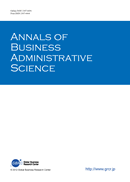All issues

Volume 12, Issue 6
Displaying 1-4 of 4 articles from this issue
- |<
- <
- 1
- >
- >|
-
Nobuo TAKAHASHI2013 Volume 12 Issue 6 Pages 277-290
Published: December 15, 2013
Released on J-STAGE: December 17, 2013
JOURNAL OPEN ACCESSIn Japanese companies, most of decisions at first seem to be illogical according to game and decision theories; however, they are in fact logically led by the high future parameter. In a non-zero sum environment, typified by the prisoner's dilemma game, there is no convincing equilibrium or stability. Axelrod's study on the evolution of cooperation states that players who survive are the ones who choose future cooperation over immediate benefits or revenge for past defection. In the repeated game of the prisoner's dilemma, the future parameter is defined as the probability of playing the next move. The future parameter is not simply a theoretical number; a high future parameter gives meaning to the actual behavior of organization members on the shop floor and those in the office. It forms the basis of the day-to-day experiences of Japanese company employees, giving them something from which they can derive a sense of achievement, something for them to feel worthwhile doing, and something to live for.View full abstractDownload PDF (239K) -
Seeking an Effective Product Development ProcessMasato ITOHISA2013 Volume 12 Issue 6 Pages 291-309
Published: December 15, 2013
Released on J-STAGE: December 17, 2013
JOURNAL OPEN ACCESSThis paper clarifies the mechanisms and conditions for improving product development performance in overlapping development processes. The (1) product design (upstream) process and (2) mass production preparation (downstream) process are interdependent. Yet, the results of case studies of Company X revealed insufficient robustness against noise that affected product functions in Product A during process (1). In process (2), although overlapping was routinely conducted, subsequent work was subject to continuous redesigning and did not result in a shorter product lead time. In contrast, for Product B, while more man-hours were required, the robustness of preliminary information was obtained by introducing Quality Engineering (QE) in process (1). As a result, by actively utilizing preliminary information prior to production preparation, the mold designer in process (2) is able to perform a “prior examination of the mold,” using methods, such as flow analysis. Moreover, access to the product designer allows the mold designer to pinpoint manufacturability problems/issues and implement the design for manufacturing (DFM) approach prior to production preparation (drawing release). Accordingly, in addition to the exchange of preliminary information, a condition that enables substantial overlapping is the frontloading and commencement of the (2) mass production preparation process at the (1) product design stage. Consequently, meeting this condition enables a considerable reduction in the amount of redesigning required to ensure manufacturability in process (2), a substantial improvement in mass production preparation performance, and a shortening of the overall lead time.View full abstractDownload PDF (336K) -
Yukari MIZUNO2013 Volume 12 Issue 6 Pages 311-326
Published: December 15, 2013
Released on J-STAGE: December 17, 2013
JOURNAL OPEN ACCESSThe deterioration of corporate performance is inevitable, and generally, corporations choose measures such as curtailing investment and reorganizing personnel. However, in the case of Kyoritsu Electric Corporation, the company's subsequent core strategy was determined amidst deteriorating performance, and aggressive investments were made in human resources, facilities, and M&A, which were deemed good opportunities. These decisions led to industrial adaptations and peripheral expansions using core technology, overseas expansion, and organizational growth in subsequent periods of economic recovery. Furthermore, before experiencing the downturn in performance, the company engaged in activities such as exploring customer-driven ideas, searching for industries with potential technology adaptation, internally retaining funds, securing procurement methods, developing an internal organizational structure, eliminating vertical organizations, and delegating authority. In other words, the company conducted organization building as a “provision” for withstanding such situations. Although Chandler (1962) advocates “structure follows strategy” for periods of organization building after growth in boom periods, the company turned recession into a turning point for growth by choosing a behavior pattern opposite to that advised by Chandler.View full abstractDownload PDF (287K) -
A Review of Three Research StreamsHeejin KIM2013 Volume 12 Issue 6 Pages 327-343
Published: December 15, 2013
Released on J-STAGE: December 17, 2013
JOURNAL OPEN ACCESSMuch research has been conducted about transferring the headquarters (hereafter HQ) staff to subsidiaries (expatriation). On the contrary, this paper reviews existing researches on transferring subsidiary staff to the HQ (inpatriation). Inpatriate staff clearly form a heterogeneous group and differ from expatriate staff in terms of their positions, strengths, and roles. The overall stream of related researches can be summarized into three topics. (1) Empirical surveys on Japanese companies have been conducted since the late 1980s, in which inpatriation was considered as a tool for localization of human resources. (2) Growing business opportunities in emerging economies stimulated researches on inpatriation since the late 1990s, especially focusing on Western multinational corporations. A research group headed by Harvey discussed the need for inpatriation and management issues that inpatriate staff may encounter at the HQ; Collings and his colleagues discussed the importance of strategic global staffing and preconditions for inpatriation. (3) In the 2000s, Reiche and others discussed knowledge transfer by inpatriate staff and the factors that facilitate this process (i.e., inpatriation) as a means of knowledge transfer in multinational corporations. It is possible that inpatriation, which has been discussed within the context of localization of human resources since the 1980s, will now present a new solution for many Japanese companies that are struggling to gain or transfer market knowledge from emerging markets.View full abstractDownload PDF (265K)
- |<
- <
- 1
- >
- >|